
(9/28 through 10/7/98)

Our journey started with Air France flying us overnight from Houston to Paris (cold and women were wearing winter coats) and then on to Rome (a very bumpy trip). Rome greeted us sunny and warm. While there seemed to be no customs or immigration, we did find police with machine guns and dogs were sniffing around looking for smuggled contraband -- maybe someone trying to bring pasta into this place or something. We were to find many police in Rome, most of them looking like teenagers. We also found a general disregard for minor laws like paying for bus rides and anything to do with the smooth flow of traffic. Somehow this place works and no one got killed. Must be the Grace of God. The grace of gravity and any other natural laws wouldn't do it.
Our B&B owner, Giancarlo Negri sent his son, Mario, to pick us up from the airport and transport us to the Roma Bed and Breakfast. Mario gave us some tips on where to catch the bus, etc.
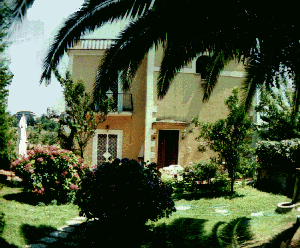 |
Our Bed and Breakfast -- In the back was our room with quite a large patio for visiting with other guests who were more lost than we were. |
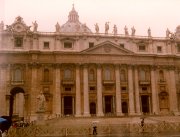 Seeing Red
Seeing Red 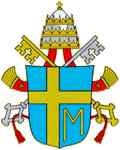
No sooner did we unpack than (with no evidence of jet lag) we jumped on Bus 881 (our main launching pad) to St. Peter's Basilica. We found it to be beautiful and massive. By luck, Pope John Paul II was to say Mass at 5pm so we stayed but had to stand. He consecrated a Bishop right before our very eyes! From the distance (about 100 yards), the Pope looked quite good. We stayed until 6:10pm, running out of energy before the Pope ran out of mass. We went to a Trattoria for dinner and at 7:30pm we saw one of the priests who attended the ceremony pass. The Mass was 2 1/2 hours long! The dinner was less than memorable - we had to pick our own antipasto and the fruit dessert had lots of sugar on it. (The Italians call it Fruita Dulce and it is way too sweet).
It rained! How could that happen. (Actually it happened at times during 4 of our 10 days in Rome but generally we were able to work around it. That means we went into a cafe and drank beer until it stopped.)
Our first stop of the day was to a park in the northern part of the city where the rich built summer villas to escape the swampy areas such as the Vatican. The primary reason for this was malaria although I don't think historically that man had figured out it was carried by mosquitoes. (Hey, if you're the Pope, you don't need science to do the right things). We went to the Museo Borghese which turned out to be sold out -- but we were able to buy tickets for Tuesday and a lunch.
We walked past the Zoo (which the guidebooks panned). It had tremendous gates but not good enough to lure us inside.
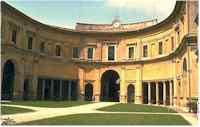 |
After a walk through the greenery/rain we arrived at Villa Giulia which has the best Etruscan Art collection in Italy. Villa Giulia had the typical courtyard found in almost all Roman palaces. The Etruscans were bronze age folk who were eventually subjugated by the Romans. A tremendous thunderstorm forced us back into the museum after its closing. |
Finally the rain let up and we were able to get to the subway on our way to the catacombs (or so we thought. Like life, a lot of our trips took us to good places while we thought we were going somewhere else.) When we emerged from the subway stop, we serendipitously turned toward St. John Lateran and viewed this tremendous basilica with mammoth statues of the Apostles. This church was the headquarters for the Popes before the Avignon (France) exile. We also toured the cloister attached, which displayed relics from the original church on that site, probably going back to the fourth century.
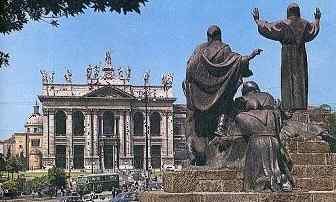 |
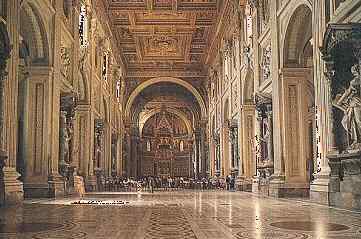 |
Across the street was the Church of St. Scala Sancta (Holy Steps). Pilgrims climb on their knees steps covered with wood until they reach a chapel at the top where only the Pope can say Mass. Needless to say, we took the side steps.
We then got somewhat lost (a frequent occurrence at this stage of our trip) trying to walk towards several other churches which we eventually found: Santi Quattro Coronati (4 crowns - 4 churches stuck together with leaky roofs) and San Clemente (where we arrived too late to visit).
Returning to St. John Lateran's we rested and had a beer across from the Pope's Residency before the French Exile. We then took the Metro (subway) to the Vatican area (where we routinely would catch a bus to the B&B). By luck, we had a delicious dinner at "L'Abruzzese" (a Trattoria that was family run and had absolutely delicious food - we returned there another 3 times during our stay).
One of Dick's favorite statues since he first taught Virgil's Aeneid in 1969. Reminds him of work except this guy had a better dress code!
|
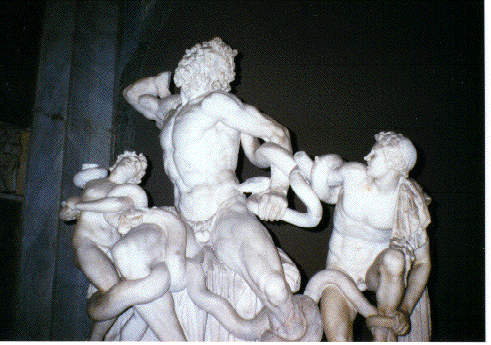 |
We spent a long day (10:30-4:30) at the Vatican Museum after about a 45 minute wait in line. We saw room after room with painted and/or decorated ceiling plus art objects (mostly sculpture). It had several famous classical Greek statues in the courtyard, including the Laocoon (above). The tour ended with the Sistine Chapel, which had been refurbished in 1994. The chapel is absolutely stunning and awe inspiring.
Since we were in a foreign country (although a quite small one -- but not the smallest enclosed by Italy), we sent postcards to Pietrina's Mom, her Aunt Anna, and her maid-of-honor Andrea from the Vatican Post Office. Dick decided to remain incommunicado to his relatives and friends (other than Pietrina, of course, to whom he frequently grunted.)
While we were surrounded by some of the most beautiful objects in the Western world, we found graffiti on just about every building in Rome - very ugly! Dick said they should take away spray paint from the kids and give them power washers.
Before dinner, again, we had a beer at a sidewalk café -- what else can you do when your feet collapse at 6PM and the Roman restaurants don't open until 7:30?
 |
Talk about sagging arches, our feet were killing us by the end of the first few days! |
Had dinner at a fixed price Trattoria (had noodles w/sauce and small amount of ground beef, chicken slices, and French fries. I had water and Dick had a beer). An OK dinner but nothing special.
Our day started with a mad rush to St. Philip Neri's Chiesa Nouva but by the time we got there, it was closed until late afternoon. We found this to be typical that we'd rush out of the B&B in the morning trying to see something before it closed before the long lunch/siesta break.
| We walked along Via Veneto, a trendy shopping district made synonymous with decadence
by in Fellini's La Dolce Vita, on our way to the Villa Borghese Museum.
This museum is quite a wonderful place which the Romans had closed for 13 years to
refurbish. A Bernini marble statue in each room and all of them breathtaking beautiful.
(On one of them, the restores found that the delicate leaves hummed like fine crystal).
Looking back, we could have seen only this and the Vatican Museum and been very happy.
Upstairs is a picture gallery which the Romans only allow 30 minutes to visit which is far
too short of a time. Throughout the museum the digital guide made it easy to find the
highlights and hear their background. (We were to find out from other museums that this
was unusual for a Roman museum). To the right is the best sculpture in the museum. Daphne is fleeing Apollo by turning into a tree rather than giving in. Supposedly the leaves (carved in marble) hum like fine crystal when stroked. To see an enlargement of this maiden who wood-n't give in, click on it. |
 |
We then went to the Vatican to get our tickets for the next day's Papal audience. In typical Roman fashion, the Swiss guards (after about a half hour) informed us that we had to go back into the city to get our tickets from the North American bishops conference. We took bus #64 (famous in the guidebooks for pick pockets) to the general area and followed the maps until they ended. A local craftsman was able to tell us in Italian where to get to the bishop's palace. (All big buildings in Rome are made from old palaces).
We arrived and realized that the palaces fill up the city block but have courtyards inside. Upon entering, the noise and clamor of the city seem ages and miles away and all is calm. In this case, a young nun talked about what to expect at the audience and how we could get into a front seat where we would be likely to be touched by the Pope.
.
| After that, we went to the Piazza Novana for dinner at an outside
restaurant where we were constantly besieged by flower sellers (who entrepreneurrly turn
into umbrella sellers at the first drop of rain) The Piazza has three fountains, the most famous being the one on the right with Neptune stabbing the calimari. Needless to say, we didn't have seafood that night. |
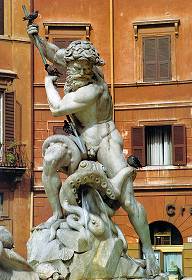 |
|
(Click on either of these pictures to see an enlargement) |
As directed by the young nun the day before, we arrived at St. Peter's Piazza at about 8am. While we had to unzip the backpack, we didn't go through metal detectors, etc. Before his 9:30 audience (of thousands), the Pope went by in front of us (almost close enough to touch) in his Pope Mobile to shake hands or bless you (check the picture). He spoke in 5 languages but did not look good when he passed us by. |
Pietrina (left), Dick's hair, and John Paul II |
Again, we had lunch at our favorite Trattoria which is about 150 yards from the Vatican. Besides the antipasti, we tried the Italian pizza - this had a very thin crispy crust.
| Next we wandered to the Trevi Fountain and walked near the Palazzo del Quirinale (The Italian President's Palace which had been a summer residency of the Popes -- again to get away from the marshy Vatican area during the malaria summertime). A Roman tradition is that at this fountain you throw a coin over your shoulder into the pool so that you will return to Rome. Of course, we did this and will return, but not any time soon. (Click here for a nice photo essay of Rome's other fountains.) |  Here's a great picture of the fountain by Tony Wheeler -- if you want to see a panoramic view we took just click here |
|
We then trod up the back way to the Spanish Steps. When we found ourselves
at the top it was an easy walk down. Michelangelo designed these steps in combinations of
12 with a little stopping area, just like USA steps. At the bottom, the fountains led to
more famous buildings and the toniest shopping area in Rome. We confined ourselves to
window shopping and didn't even buy windows. For a dinner spot, we checked our EyeWitness Guide Book (loaned to us by Joe and Veronica who had honeymooned in Rome). The book recommended Mario's --and we do too. It was good food, reasonably priced |
.
|
(Warning--multi-lingual pun coming!) Temple fugit, thanks to a lot of help from later Popes who stole the marble. But then a lot of Roman Emporers lost their marbles while still in power. |
 |
By now we were getting pretty good at getting around Rome without getting (too) lost. We took the subway to the Coliseum and had an audio tour with phones. We found these audio tours to be worth the price (usually about $4). This explained much: how the Coliseum had wood floors over the tunnels, the plumbing system, where the various social classes sat, etc. Most of the Coliseum had been stripped of marble and statues by the Popes and other despoilers of Rome (a tradition which continues with the graffiti artists).
In the picture below, you see the cells of the basement at bottom. These would be covered by wood floors. Animals would be brought up by elevators. The arch at the far end is where the gladiators exited (assuming they could leave on their own two feet.) If they tried to fake their death, attendants would stab their bodies with glowing-hot steel rods. The Romans sure knew how to get the last bit of productivity from their workers.

Next we walked through the Roman Forum and ruins along the edge. This is quite a large area currently being excavated (in fact, we saw a dig in progress). Unfortunately, a hard and recurring rain dampened much of our enthusiasm for this place.
|
A few short blocks away we visited San Clemente Church, which we had gone to earlier but found it closing just as we got there. This time we stayed. This is quite a place with three levels: top - 12th century Church; mid - 4th century Church; bottom - 1st century Cult to male fertility. (Bill Clinton, eat your heart out.) |
| We then took the subway to the Vatican area photographer to pick out our
picture of the Pope blessing us. Entering the subway car, Dick found a pickpocket's hand
in his (Dick's) pocket. Extracting it, he found himself holding hands with an Italian for
several seconds with both shouting at each other in languages neither understood.
(Shrieking in tongues, you might say). After this happened, an Italian on the subway told
Dick that the man was the station's pickpocket. No cabineri were around to apprehend him; however, a photographer named Michelango snapped this picture of Dick stopping this nefarious deed. You will notice that it would be hard to pick the pickpocket's pockets. |
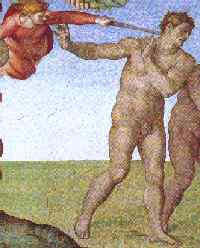 |
Based upon a co-worker's recommendation, we went to the Trastevere area for dinner at Sabatini's. This was the most seriously lost we got until Dick pulled out his boy scout compass and realized that because of the curve of the river (Trastevere means across the Tiber) what he thought was North was instead South. We finally got to Piazza Santa Maria in Trastevere 5 minutes after its most famous church closed; fortunately the bar across from it was open and we sat there until the restaurant opened at 7:30.
At dinner, we started up a conversation with a very nice couple (John and Julia) from Cambridge, England. Dick and he talked much about John's school (Churchill College started up by Winston to be an English MIT) and several interesting experiences John had during his diplomatic career (such as being on the British UN team during the Falklands war. At the end Dick and John exchanged business cards and Dick, of course, looked him up later on the web. Turns out John is Sir John Boyd, dean of the college and former British ambassador to Japan. (But Dick said at least his Exxon business card was in color in a classic pique of American one-upmanship). Pietrina and Julia talked about families and Rome (it has water but no plumbing -- I could not find the knobs for the hot/cold water and she told me the button was on the floor!).
| By this time we were experienced Rome mass transit travelers (as opposed to just travelers to mass as we sometimes are in Houston) -- with much stamina. Our first stop was the Pantheon -- the world's largest domed building built by the Romans during the first century. (This trip has given us profound respect for Roman engineering). Luckily an emperor had given the Pantheon to the Popes who converted it into a Church and therefore did not strip it too much. (OK, one of them melted some bronze to make Bernini's altar pillars in St. Peter's, but nobody's perfect, not even a pope). At the top of the coffered dome is the oculus -- an opening like the eye, which brings in light (and rain). The dome was made of heavy rock at the bottom to support the weight with progressively lighter lava rock as the dome climbs 50 meters or so upward. This building became the model for many things including the USA Capital. Unfortunately, our politicians seem to be picking up some of the decadent habits of Roman emperors, not just their architecture. |  |
|
After a brief sunlit lunch at Piazza Navona we ventured by subway/bus along one of Rome's oldest roads, the Via Appia Antica, to the Catacombs of San Collisto. This was the burial area for Romans (called a Necropolis -- city of the dead) long before the Christians took it over. Graves were carved directly into the Lava rock below. When one level filled up, a lower level would be started. The catacombs have 3 levels and our guide was devoutly religious. Each floor was 4-5 graves high and small graves were for the babies/children. (Over half the Christians buried there died in their first year of life). There were a few altars for Mass. No bones were left in the graves. |
After the catacomb tour, we walked along the Via Appia Antica for a while. This road is in easy sight of the sights of Rome but seems far in the country.
Dinner was at our favorite Trattoria, followed by the traditional bus ride home and hike up the steep hill to our B&B.
A storm arrived during the night but we typically slept well after a day of walking and sun.
The morning started with us knowing exactly where we were going in the rain -- only to find that a Pope had put a huge wall up several centuries before and we had to walk several miles (uphill!) out of our way. Finally we entered the Janiculum district and had an Italian breakfast (rolls and coffee) before entering two state-run (ugh) museums: the Villa Farnesina (with the world's greatest porch -- decorated by Rafael) and the Palazzo Corsini.
We went to the Palatine to see two museums: Again, we found them to be taken over by the state and dirty, dusty, no identifications, etc. One of the museums was a courthouse so there were many weddings this day and Michelangelo's piazza was filled with couples -- most of them older as this was probably their second marriage, which couldn't be held in the church. Often their children attended them.
When the rains got to be too much, we used the guidebook to find the Da Paris Restaurant in Trastevere. By luck, the women eating alone at the next table was a very interesting woman who took charge of recommending food and ordering for us to the Italian waiters. Her name was Lucianna who was about 74 years old. She was a lifelong liberal who was imprisoned by Mussolini when she was 16 years old. After the war, she attended Harvard as a Fulbright Scholar. Afterwards, she traveled through 44 states giving speeches.
After her studies, she became a political journalist, writing in Italian and French. She is currently employed, she says, as a Grandmother. She lives in the neighborhood and comes to that restaurant almost daily so they just gave her own food. We warmed up from the cold rain with a delicious soup of pasta and beans, then fish with potatoes, a caramel dessert with café. It was raining so we were glad to stay for awhile. By the time we finished, the rain had stopped.
We then made our way to a Baroque Concert at St.Catherine of Sienna Church across the Tiber. It was excellent chamber music in an acoustically perfect (and beautifully furnished) church: oboe, violin, cello, and clavichord (original piano). It started at 7 and lasted about 1 hour. This was our only musical event of the trip.
We took our only packaged tour: The Appian Line Bus Tour to Naples/Pompeii/Sorrento. We started quite early by hiking to the Holiday Inn where Dick had his only American breakfast of the trip. We then traveled south on a superhighway through the beautiful Italian countryside (more lovely than California which like Italy has mountains and sea -- but lacks the rich green vegetation). We first went through Castelli Romani, a region of Ciociaria with a view of the Abbey of Montecassino, completely rebuilt after 2nd world war.
Naples was sunny as we toured it without leaving the bus tour (except to use a tiny bathroom, for a fee, of course). Naples is still rebuilding after World War 2 (52 years later!). To give you an idea of the climate, Naples grows oranges.
Our Pompeii visit started with a non-descript lunch in a local restaurant -- however, we sat with a couple from Houston who had spent the previous two days in the Houston airport while KLM screwed up their flight. Our tour of Pompeii had a knowledgeable guide. We found that 2,000 people out of 22,000 were killed by poisonous gas in three days. (The lava did not cover the city -- rather it was ashes and poisonous gas.) Women, children, and old people died and then looters came but died also. It was very interesting.
Our bus then drove along the twisted coast to the peninsula of Sorrento -- a truly breathtaking drive. Our brief stay there was nearly entirely confined to the Notturno inlaid wood works factory. We ordered a six-piece inlaid wood table to be made and shipped by UPS in 2 months. The owner who was also the salesman worked several years on off-shore rigs in the Gulf of Mexico. Sorrento grows olives for olive oil and puts nets under trees in October so that gravity can harvest the fruit.
Naples, Pompeii, and Sorrento make up cities around water and are very tranquil and beautiful.
We got back to the B&B about 10:30pm. We enjoyed the Italian country side and hope to come back to visit.
Our last day in Rome.
The night before we combed out guidebook to see what was left worth seeing. Our first stop was to Chiesa Nuova (The church of St. Philip Neri whose order rivaled the Jesuits for counter-reformation zeal). After that we took a bus towards the ONLY REMAINING MUSEUM IN ROME that we hadn't seen. Upon entering the bus, a woman asked us if we were on the right bus! (This was highly unusual as no one in Rome offers to help with directions.) Turns out she was a Dane living in Rome and travelling throughout the world. In fact, she was to leave for Iraq the following day.
She directed us to the museum which, when we got there, was closed for three days because of mourning. (I'm sure someone in Italy died giving them a reason to have three days off.) We then walk/bussed to Piazza del Popolo, where we fought the rain and saw two more churches (which appear to be twins from the front plaza view but are different from the size due to the differing size building sites), a large plaza with Michelangelo statues (closed, of course, for remodeling), a Dali museum (also closed), and formal gardens (quite unusual for Rome).
We then spent the time before lunch at one of the major churches in a city of hundreds of churches -- Santa Maria Maggiore. Like many of the other basilicas, this church had several sections closed for refurbishment. Unlike most others, it had its own Sistine Chapel (as a Pope named Sixtus had built a modest remembrance to himself there).
| After finding our first lunch place closed, we trod down under another
historic arch and found a delightful restaurant for a long lunch. Afterwards, we went to St. Peter's to hike up to the Cupola (elevator up and then 350 steps to the top - a great view of the city but our panoramic camera was finished. Luckily some other netizen planned better and so we stole his picture to the right. This is exactly how it looked).. We took an early bus home (typically we arrived home at 10:30--midnight) and got pizza and a beer (from a Coke Machine!) and then packed. |
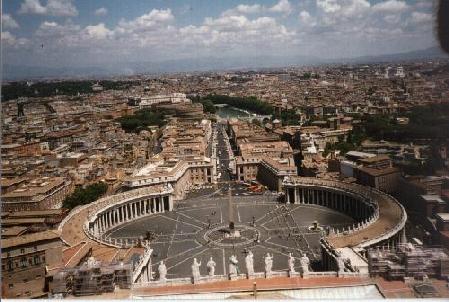 |
OVERALL VIEWS OF ROME:
They have very small cars and lots of motor bikes. You can cross and they just edge up until you pass and then zoom away.
The papacy for centuries was the continuation of the Roman emperor line. Only in the 20th century did the spiritual dimension override the temporal. This is evidenced by the Roman emperors trying to build the biggest buildings and trying to convince the populace that they were gods and the Popes building the biggest buildings (often with the stones stolen from the emperor's buildings) and trying to convince the populace that they were saints. Centuries later we are left with a lot of names on buildings that need a good power washing. Both emperors and popes seemed to suffer from the edifice hex.
Land is owned but underneath is free and that is where the catacombs are (even under Rome).
Excavations are still being done and finding old parts of the city.
Buses are free (only Nuns, Priests, and old people put in bus tickets to get stamped). The Metro (subway) is good and most people seem to pay for it. Pick pockets (we saw two and Dick got to hold hands with one) are available at reasonable cost.
It rained 4 out of 10 days but we still walked all around. Dick lost an inch off his waist and at least four pounds. Luckily, belts (and most other leather goods) were cheap and plentiful.
Flowers: Oleander, Bougainvillea, Wisteria, and Hibiscus. They don't get frost so everything they have is lush but just not in too many places. Rome needs more areas with trees/flowers.
Graffiti everywhere. It really looks bad.
Rome is a work in progress. The Communists are in office and are fixing up 700 sites including just about anything you will want to see. What we saw a lot of was scaffolding and building cranes! All is supposed to be done by the Jubilee year of 2000 but I wouldn't count on it. Rome was not remodeled in a day (and have you ever hired an Italian contractor? -- sorry, politically incorrect old Detroit joke). If you want more details, check out this link:
Flew to Paris. Policemen with machine guns were walking around.
Dick went to review a project at Esso France and Pietrina took a Paris Vision Discovery bus tour of Paris. We had earphones for whatever language we needed. Paris was very cold (45-50F) and overcast. It was hard to see the top of the Eiffel Tower. Rome is better for marble statues but Paris has more gardens with trees and flowers. The phone cannot have any coins - it has to have a card for use.
Stayed at the Sheraton at DeGaulle Airport. Very handy and quite a modern room.
At the Sheraton, Air France counter was there so they changed our seats to bulkhead and took our luggage to the terminal for us and wrapped the luggage in plastic.
The flight home was uneventful. Pietrina watched a Robert Redford movie with horses. (Robert was the old white guy). Dick started reading a book about learning French (Good thing to do while leaving Paris). We arrived in Houston at 2:15pm and everything was very crowed. We went through customs and there was a dog sniffing the luggage for fruit.
**Our passports were NEVER stamped in Rome or Paris. It looks like we never went on a trip!
If you've read this far, we don't believe you. Send us email to prove it!
![]() Send Pietrina and Dick Email
Send Pietrina and Dick Email ![]()
![]() Return to Schmitt Home
Page
Return to Schmitt Home
Page